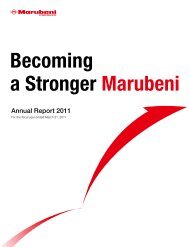Trust Recovery Growth Vitalization - Marubeni
Trust Recovery Growth Vitalization - Marubeni
Trust Recovery Growth Vitalization - Marubeni
You also want an ePaper? Increase the reach of your titles
YUMPU automatically turns print PDFs into web optimized ePapers that Google loves.
ealized gains and losses and devaluation losses associated with<br />
marketable and investment securities; allowances for bad debt,<br />
and losses stemming from the realignment of <strong>Marubeni</strong> Group<br />
companies. To improve their financial position, <strong>Marubeni</strong> and its<br />
consolidated subsidiaries have taken steps to reduce total assets<br />
and net interest-bearing debt, reduce or establish allowances for<br />
underperforming and unprofitable assets, pare down expenses,<br />
shift resources to high-growth fields, and minimize exposure to<br />
high-risk assets. While <strong>Marubeni</strong> and its consolidated subsidiaries<br />
are confident that substantial progress has been made in enhancing<br />
their financial positions, there is no guarantee that greater<br />
losses will not be posted in the future.<br />
4 Significant Estimates<br />
<strong>Marubeni</strong> prepares its consolidated financial statements in<br />
accordance with accounting principles generally accepted and<br />
recognized in the United States. In preparing important accounting<br />
policies and these statements, certain accounting estimates and<br />
assumptions are utilized as needed when calculating assets and<br />
liabilities as of the fiscal year-end, the disclosure of contingent<br />
assets and liabilities, and earnings and expenses incurred during<br />
the year. In determining accounting estimates and assumptions,<br />
management makes what it believes to be a reasonable inference<br />
of these amounts based on past experience and on a case-by-case<br />
basis. Estimates and assumptions made in this way have an<br />
inherent degree of uncertainty, and actual results could differ from<br />
those estimates. Management considers the following estimates<br />
and assumptions will have a material impact on the Company’s<br />
consolidated financial statements.<br />
Allowances for doubtful accounts<br />
When evaluating credit risk associated with accounts receivable,<br />
notes receivable, loans receivable, and other receivables,<br />
<strong>Marubeni</strong> and its consolidated subsidiaries classify such according<br />
to latent risk carried by the obligor or geographical region concerned.<br />
Based on this classification, an allowance is established<br />
for a given receivable considered as a loss, posted at an amount<br />
equal to the current value of the receivables (projected cash flow<br />
minus the initial effective interest rate), or the fair value of the<br />
asset as collateral. Projected cash flow and fair value as collateral<br />
<strong>Marubeni</strong> Corporation 2005<br />
are estimated based on the most accurate credit information<br />
available from specialists regarding the past payment history of<br />
each applicable obligor or region. For general receivables not<br />
covered above, allowances are calculated based on the historical<br />
rate of default for each risk category. The historical rate of default<br />
is determined by specialists, based on past experience in each<br />
applicable risk area.<br />
While <strong>Marubeni</strong> believes these estimates to be reasonable,<br />
unexpected changes and other factors could significantly impact<br />
the Company’s consolidated financial statements.<br />
Valuation of marketable securities<br />
In accordance with Statement of Financial Accounting Standards<br />
No. 115, Accounting for Certain Investments in Debt and Equity<br />
Securities, published by the FASB, <strong>Marubeni</strong> and its consolidated<br />
subsidiaries classify securities as trading, held-to-maturity, or<br />
available-for-sale.<br />
Held-to-maturity securities are stated at amortized cost,<br />
adjusted for amortization of premiums and accretion of<br />
discounts to maturity. Available-for-sale securities are carried at<br />
fair value with the unrealized gains and losses, net of taxes,<br />
reported in accumulated other comprehensive loss in shareholders’<br />
equity. For held-to-maturity and available-for-sale<br />
securities, declines in value judged other than temporary are<br />
posted as devaluation losses.<br />
Declines in the value of marketable securities judged other than<br />
temporary are determined by examining the length of time that<br />
market value remains below book value and the percent decline in<br />
value. For securities without market quotations, a comprehensive<br />
examination of the possibility of recovery—based on projected<br />
business results—net assets and other measures of the percent<br />
decline in actual value, are used to make this determination.<br />
While <strong>Marubeni</strong> believes these estimates to be reasonable,<br />
unforeseeable changes to the assumptions used could result in a<br />
higher-than-expected loss, which could significantly impact the<br />
Company’s consolidated financial statements.<br />
Loss on long-lived assets<br />
Projected cash flows are utilized when determining devaluation<br />
losses for long-lived assets held by <strong>Marubeni</strong> and its consolidated<br />
subsidiaries. Projected cash flows are estimated based on a preestablished<br />
set of criteria.<br />
66 / 67


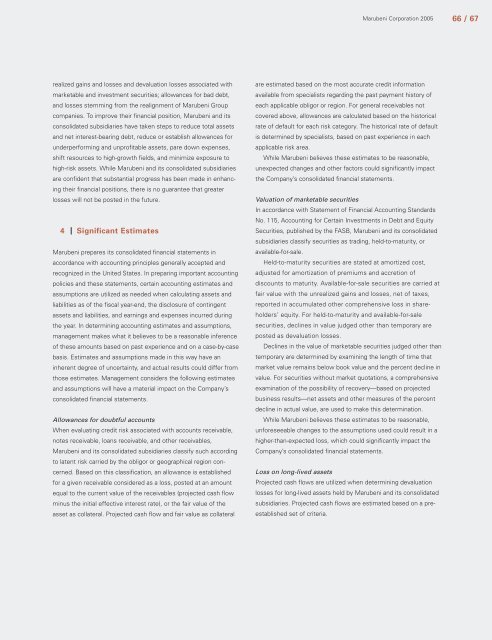
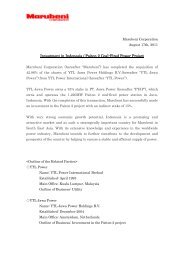
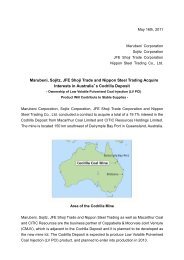
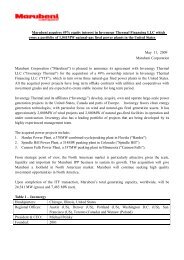

![[Chapter 2] Driving Growth: Expansion Under SG-12 - Marubeni](https://img.yumpu.com/4161147/1/190x248/chapter-2-driving-growth-expansion-under-sg-12-marubeni.jpg?quality=85)


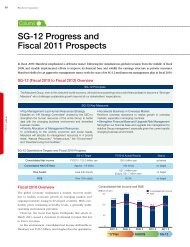
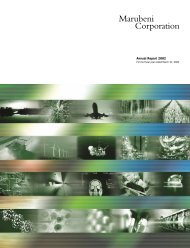
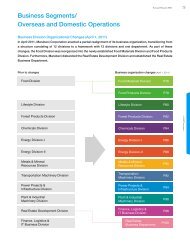
![[Chapter 4] Delivering Growth - Marubeni](https://img.yumpu.com/3464783/1/190x248/chapter-4-delivering-growth-marubeni.jpg?quality=85)
